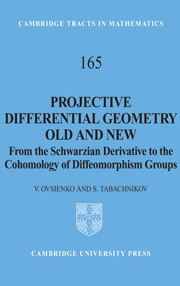 Projective Differential Geometry Old and New
Projective Differential Geometry Old and New Book contents
- Frontmatter
- Contents
- Preface: why projective?
- 1 Introduction
- 2 The geometry of the projective line
- 3 The algebra of the projective line and cohomology of Diff(S1)
- 4 Vertices of projective curves
- 5 Projective invariants of submanifolds
- 6 Projective structures on smooth manifolds
- 7 Multi-dimensional Schwarzian derivatives and differential operators
- Appendices
- References
- Index
4 - Vertices of projective curves
Published online by Cambridge University Press: 14 August 2009
- Frontmatter
- Contents
- Preface: why projective?
- 1 Introduction
- 2 The geometry of the projective line
- 3 The algebra of the projective line and cohomology of Diff(S1)
- 4 Vertices of projective curves
- 5 Projective invariants of submanifolds
- 6 Projective structures on smooth manifolds
- 7 Multi-dimensional Schwarzian derivatives and differential operators
- Appendices
- References
- Index
Summary
The four-vertex theorem is one of the first results of global differential geometry and global singularity theory. Already Apollonius had studied the caustic of an ellipse and observed its four cusps. Huygens also studied evolutes of plane curves and discovered their numerous geometric properties. Nevertheless the four-vertex theorem, asserting that the evolute of a plane oval has no fewer than four cusps, was discovered as late as 1909 by S. Mukhopadhyaya.
We start with a number of beautiful geometric results around the classic four-vertex theorem. We then prove a general theorem of projective differential geometry, due to M. Barner, and deduce from it various geometrical consequences, including the four-vertex and six-vertex theorems and the Ghys theorem on 4 zeroes of the Schwarzian derivative. The chapter concludes with applications and ramifications including discretizations, topological problems of wave propagation and connection with contact topology. A relates Section A.1 concerns the Sturm-Hurwitz-Kellogg theorem on the least number of zeroes of periodic functions.
This chapter illustrates the title of the book: it spans approximately 200 years, and we see how old and new results interlace with each other. The literature on the four-vertex theorem is immense. Choosing material for this chapter, we had to severely restrict ourselves, and many interesting results are not discuss here.
- Type
- Chapter
- Information
- Projective Differential Geometry Old and NewFrom the Schwarzian Derivative to the Cohomology of Diffeomorphism Groups, pp. 69 - 102Publisher: Cambridge University PressPrint publication year: 2004
